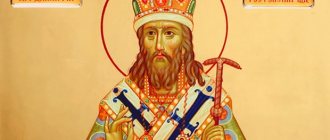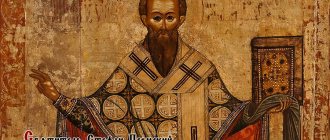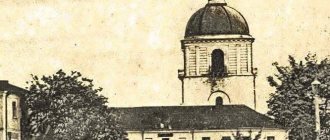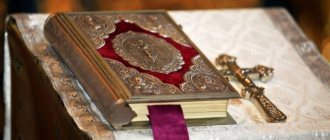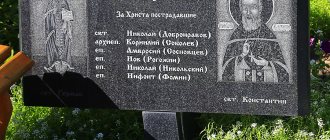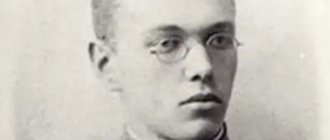Life of Saint Leonty of Rostov
The future Saint Leonty of Rostov was born no later than 1051. Saint Simon (? - May 22, 1226), Bishop of Vladimir and Suzdal, in a letter to the Kiev-Pechersk Archimandrite Akindinus (d. after 1231), attached to the Pechersk patericon, listing the tonsures of the Kiev-Pechersk Monastery and naming among them Saint Leontius, calls him the third “citizen of the Russian world.” The future saint was baptized in infancy (“sanctified from the shrouds, from young nails”), then, according to the order of Prince Vladimir (c. 960 - 1015) or Yaroslav (c. 978 - 1054), he was taken “into teaching bookish" (“Russian books have been a storyteller since youth”) with the goal of elevating over time to the spiritual rank (“for God has chosen you from youth, Father, the shepherd of the sheep of words, so they will perceive the face of the venerable ones”) [].
Leonty knew the book well and from a young age he felt a craving for monastic life, and for further study he was sent or voluntarily went to Constantinople, where he may have been tonsured a monk. Upon his return from Constantinople, he came to the Pechersk monastery to the Monk Anthony (983-1073), which was no earlier than 1032, from where he was called to the Rostov See as an educated monk and ordained a bishop “as the first altar” from the Pechersk monks before 1051 the year when the second altar and tonsure of the Kiev-Pechersk Monastery, Hilarion (d. c. 1055), was elevated to the rank of Metropolitan of Kiev [].
In Rostov, Saint Leonty was a fighter for the Christian faith. The first Bishop of Rostov, Theodore, built an oak, “wonderful and great”, according to the chronicle, in Rostov cathedral church in the name of the Dormition of the Blessed Virgin Mary during the time of Prince Vladimir, in 991, and a church clergy was established under it, but there were few Christians, yes and Saint Theodore himself, as well as his successor Hilarion, were expelled from the city [].
Greeted with hostility by the elders of the city of Rostov, Leonty settled at the cathedral church and, first of all, took up the education of the clergy. A monument to this educational activity of Saint Leontius is what has come down to us and is attributed to him in two manuscripts: “ Teaching and punishment to the priests about everything, how it is appropriate to teach your children spiritually and give penance to them, according to the commandments and according to the rule of the holy fathers .” This teaching has no resemblance to others bearing the same names. It talks about the importance of the priesthood, repentance, penance, baptism, resurrection of the dead and monotheism. Bishop Leonty so loved the organized and spiritually and morally enlightened church clergy that he took with him to the grave a scroll with the names of the clergy he appointed: after the discovery of the relics, “you saw the great Leonty ... holding the scroll in your hand, and in it are written both celebrants and deacons , but he did not establish them with his own hand.”[].
Bishop Leonty labored in preaching Christian truths to the Rostov pagans from the populous Meri tribe, but his open preaching met first with mute resistance, and then with their open rebellion: several times they drove him away with dishonor and, finally, completely expelled him from the city. Then he settled outside the city near the small stream Brutovshtitsa, where he built a small wooden church in the name of the Holy Archangel Michael. Striving here in fasting and prayer, he sowed the seeds of Christ's faith in the hearts of the Rostov youths, whom he invited to come to him for this purpose and fed them with wheat boiled with honey. Over time, Bishop Leonty again settled in the city and zealously preached the word of God and baptized many youths and adults [].
The preaching activities of Bishop Leonty hardened the hearts of the Rostov residents of the pagan faith, and they decided to kill him. One day, with weapons in their hands, they approached the cathedral church and demanded that the bishop come out to them. “The priests and deacons of the cathedral were frightened and began to beg their archpastor so that he would not go out and secretly hide from the idolaters who were ready to kill him.” But he, putting on the bishop’s vestments, together with the priests and deacons, who, at his command, had donned sacred clothes, left the temple to the people. Struck by the bishop’s courage and the heavenly light emanating from his face, the pagans fell to the ground, fell into bodily relaxation, and lay like dead men on the ground at Leontius’s feet. Having prayed to the Lord, he raised them up and healed them; at his admonition, they accepted his faith and were baptized, and from that time the church in Rostov began to grow. There is conflicting information about the death of Bishop Leonty: according to some sources, he died in peace, according to others, he was killed by a crowd of pagans; Some place his death in 1070, others believe that he was killed in 1073. All lists of the life indicated by Metropolitan Macarius, in accordance with the first and second editions of the epistle of St. Simon, tell the story of the peaceful death of St. Leontius. And Bishop John of Rostov, in his canon to the saint, glorifies Saint Leonty as blessed and venerable, but not as a martyr. On the other hand, Bishop Simon of Vladimir and Suzdal writes the following about Leonty: “Leonty, Bishop of Rostov, the great saint, whom God glorified with incorruption, he was the first throne; after much torment, he was killed by the infidels” [].
Essays
The teachings of Saint Leontius that have come down to us in two manuscripts [6] speak about the importance of the priesthood, repentance, penance, baptism, the resurrection of the dead and monotheism.
- “Teaching to the priests about everything and punishment of Bishop Leonty of Rostov to the priests about everything, how a child should be taught spiritually and the rule of the holy fathers,” Monuments of Old Russian canon law
[Ed. A. S. Pavlova] St. Petersburg, 1908, part 1 (Monuments of the XI-XV centuries). - Ed. also: “Moscow Eparch. Vedomosti,” 1878, No. 24, 25; “Yaroslavl Eparch. Vedomosti" 1878, No. 12; “Russian Historical Library, published by the Archaeographic Commission: in 39 volumes,” St. Petersburg-Leningrad, 1872-1927; 1908, vol. 6, stb. 111-116.
Veneration of Saint Leonty of Rostov
The body of Bishop Leonty was buried in the Assumption Cathedral Church of the city of Rostov, and his incorrupt relics were found in 1162 when digging ditches under the walls of the stone cathedral church newly founded by Grand Duke Andrei Bogolyubsky (c. 1111 - 1174) on the site of an oak tree that burned down in 1160 Cathedral of the Assumption Church and at the same time were placed in a stone coffin sent by the same prince in a small chapel built in his honor on the south side of the altar of the cathedral church. Rostov Bishop John I established the celebration of the saint on the day of the discovery of his relics - June 5 (May 23, Art. Art.) and wrote a canon placed in the service (May) Menaion. But the vaults of the cathedral church soon collapsed, and the relics of St. Leontius were transferred to the Church of John the Theologian and remained there until 1231; On February 25, 1231, they were again transferred to the newly built church in the name of the Dormition of the Blessed Virgin Mary and placed in the chapel dedicated to the saint. In 1609, the Poles and Lithuanians, who devastated Rostov, stole the saint’s golden shrine and his icon, and since then the relics of St. Leonty have rested in secret, and in their place of rest there is a shrine with his tombstone icon. In 1800, a silver shrine was built for the saint, decorated with a bronze elegant gilded canopy. During the restoration of the Rostov Assumption Cathedral in 1884, under the floor of the chapel in the name of St. Leontius, an ancient chapel was opened in honor of him, in which on the south side there is a niche decorated with ancient frescoes with images of St. Leontius, the repose and discovery of his relics; next to the wall image of St. Leontius, almost level with the brick floor of the chapel, directly under the silver shrine of the saint, a tomb walled up from white stone was opened, in which the honest relics of St. Leontius rest [].
Shrine in Veliky Ustyug
In addition to Rostov, there are other places in our country where the enlightener enjoys special veneration. One of them is the parish of the Church of St. Leonty in Veliky Ustyug. The first wooden church, dedicated to the ruler of Rostov, appeared here many centuries ago, but it was rebuilt in stone in the middle of the 18th century. The parishioners loved their temple very much and donated large sums to it, and therefore this church was constantly updated. By 1830, it had turned into a spacious two-story building with several chapels, a huge belfry, an openwork stone porch and a refectory. However, during the Soviet years the temple was closed and soon fell into disrepair. Surprisingly, its revival began only in 2013 and is carried out by the local community of parishioners. In 2015, a new altar icon of the enlightener Leonty of Rostov was painted especially for the church in Veliky Ustyug at the expense of benefactors. They say that in this temple the saint answers the prayers of believers who come to him with their troubles and hopes. However, it is believed that Leonty of Rostov prays not only for ordinary people who turned to the bishop with requests, but also for the entire Russian land. It is not for nothing that he is called the great prayer book of the apostolic ministry.
Magazine: Mysteries of the 20th Century No. 21, May 2022 Category: Christian miracles Author: Elena Lyakina
Tags: legend, Rus', Orthodoxy, Mysteries of the 20th century, Leonty, bishop, Rostov, Suzdal, icon, relics, measure
- Back
- Forward
Troparion, kontakion and canon to Saint Leontius of Rostov
Troparion, tone 4
You are an apostle, and your prayer book is faithful to God, you have surpassed heavenly virtues, and you have laid love on the One who loves you, and you have converted unfaithful people to the faith. Therefore, now rejoicing with the angels, standing before the throne of glory of all King Christ God, praying to Saint Leontius, may our souls be saved.
Kontakion, tone 4
For the sake of purity of life, the All-Seer Lord, plant His light in your souls, enlighten many people with your teachings, Rev. Leontius.
Library of the Russian Faith Canon to St. Leonty of Rostov →
Read online
Saint Leonty of Rostov. Icons
Saint Leonty of Rostov is usually depicted in full growth on icons. With his right hand he blesses, and with his left hand, covered with a cloth, he holds the Gospel in a precious setting. The saint is depicted in full episcopal vestments: he wears a cassock with springs, a patrachil and a club, decorated with multi-colored stones and pearls, a polystavrion, a white omophorion and a white hood.
Saint Leonty of Rostov. Last quarter of the 15th century. Icon from the Deesis tier of the cathedral of the Rostov Boriso-Gleb Monastery on Ustye. Rostov the Great, State Museum-Reserve "Rostov Kremlin"
Saint Leonty of Rostov. OK. 1497 Icon from the Deesis tier of the Assumption Cathedral of the Kirillo-Belozersky Monastery. Kirillov, Kirillo-Belozersky Historical, Architectural and Art Museum-Reserve
Saint Leonty of Rostov. XV century “Sacristy of the Trinity-Sergius Lavra” SPGIKHMZ
Saint Leonty of Rostov. First third of the 16th century Comes from the Deesis rite of the Church of the Intercession in the village of Gumenets, Rostov district, Yaroslavl region. Rostov the Great, State Museum-Reserve "Rostov Kremlin"
Saint Leonty of Rostov. First half - mid-16th century. From the Deesis tier of the iconostasis of the Transfiguration Cathedral of the Spassky Monastery in Yaroslavl. Yaroslavl, Yaroslavl Historical, Architectural and Art Museum Reserve
Saint Leonty of Rostov. Mid-16th century Comes from the Church of the Entry into the Temple in Rostov. Rostov the Great, State Museum-Reserve "Rostov Kremlin"
Saint Leonty of Rostov. End of the 16th century Moscow, State Historical Museum
Saint Leonty of Rostov. Sewing. Moscow, 1514
There are also many iconographic images of St. Leonty of Rostov with other saints.
Saint Leonty of Rostov, Metropolitans Peter and Alexy. Second quarter of the 15th century. Double-sided tablet icon. The reverse is “Basily the Great, John Chrysostom, Gregory the Theologian.” Sergiev Posad State Historical and Art Museum-Reserve
The icon “St. Cyril and Athanasius of Alexandria, Leontius of Rostov” depicts three holy bishops: on the left - Cyril of Alexandria, in the center - Athanasius of Alexandria, on the right - Leontius of Rostov. They are presented full-length, frontally, in almost identical poses, with the Gospels pressed to the chest with their left hand. Gestures of the right hands vary: Cyril and Leonty bless, and Athanasius touches the Gospel, as if drawing the attention of those approaching the icon to it. This gesture further emphasizes the importance of the symbolic meaning of the Gospel and reminds us that one of the main purposes of the saints is to instruct their flock in the true faith.
Saints Cyril and Athanasius of Alexandria, Leonty of Rostov. Novgorod, end of the 15th century. Veliky Novgorod, Novgorod State. historical, architectural and art museum-reserve
On the icon “Rostov Saints Leonty, Isaiah and Ignatius” the saints are depicted frontally, full-length, in episcopal vestments. They hold in their hands Gospels with bright red edges and frames decorated with precious stones. Above the figures of the saints there is a segment of the sky with a half-figure of the Virgin and Child.
Rostov saints Leonty, Isaiah and Ignatius. End of the 15th century (?). Rostov the Great, State Museum-Reserve "Rostov Kremlin"
Peter Metropolitan, Leonty of Rostov, Theodosius of Pechersk. Double-sided tablet icon. Back - Entrance to Jerusalem. Part of a series of tablets from the Cathedral of St. Sofia in Novgorod. End of the 15th - beginning of the 16th centuries. Moscow, State Tretyakov Gallery
Venerable Sergius of Radonezh and the Rostov wonderworkers: Abraham, Ignatius, Isaiah, Leonty. Mid-16th century Comes from the Church of the Epiphany in the village of Uslavtsevo, Voshchazhnikovsky volost, Rostov district. Rostov the Great, State Museum-Reserve "Rostov Kremlin"
Abraham, Nikola, Leonty, Gerasim and Guardian Angel. Rostov, second half of the 16th century. Moscow, private collection
Saints Peter, Metropolitan of Moscow, and Leonty, Bishop of Rostov, and Saint Theodosius of Pechersk. Double-sided tablet icon. The reverse is “Entrance into Jerusalem.” Part of a series of double-sided saintly icons originating from the Cathedral of the Nativity of the Virgin Mary in Suzdal. Second half of the 16th century. Vladimir, Vladimir-Suzdal Historical, Artistic and Architectural Museum-Reserve
Savior Emmanuel with St. Nicholas the Wonderworker Rostov, end of the 16th century. Moscow, Moscow Kremlin Museums
Literature
- Klyuchevsky, V. O., Old Russian lives of saints, as a historical source
, M., 1871, 3-22. - Macarius (Bulgakov), Metropolitan, History of the Russian Church: in 12 volumes
, St. Petersburg, 1864-1886, vol. 2, 23-24, 315-317. - Titov, A. A., Life of St. Leontius, Bishop of Rostov
, M., 1893. - Shemyakin, V.I., Moscow, its shrines and monuments
, M., 1896, 141. - Sreznevsky, I. I., Ancient monuments of Russian writing and language (X-XIV centuries): General time-by-time review and additions with paleographic instructions, extracts and indexes
, 2nd ed., St. Petersburg, 1882, 120, 142. - Nikolsky, N.K., Materials for a time-based list of Russian writers and their works (X-XI centuries)
, St. Petersburg, 1906, 210-211. - Historical dictionary about saints glorified in the Russian Church, and about some ascetics of piety, locally revered
[Comp. D. A. Eristov, M. L. Yakovlev_], 1st ed., St. Petersburg, 1836, 167-168. - Barsukov, N.P., Sources of Russian hagiography
, St. Petersburg, 1882, 323-329. - Golubinsky, E. E., History of the Russian Church: in 2 volumes
, M., 1900-1911, volume 1, first half, 201, 202, 757-758; second half, 433. - Kamanin, I.M., Zverinetsky caves in Kiev, their antiquity and holiness
, Kiev, 1914, 40-42, 133, 137, 139. - Arkhangelsky, N.V., Newly discovered Zverinetsky caves in Kiev
, Kiev, 1915, 15. - Demetrius (Sambikin), archbishop, Months of the saints, the entire Russian Church or locally revered: in 14 issue.
, Kamenets-Podolsk, Tver, 1892-1902, issue. 9, part 2, May, 123-129. - Edlinsky, M.E., priest, Ascetics and sufferers for the Orthodox faith and the Holy Russian land from the beginning of Christianity in Russia to later times
, 1st ed., St. Petersburg, 1895, 143-145; 4th ed., St. Petersburg, 1901-1903, vol. 1, 148-151. - Tolstoy, M.V., Ancient shrines of Rostov the Great
, 2nd ed., M., 1860, 25, 33, 34, 35, approx. 13. - Tolstoy, M.V., Stories from the history of the Russian Church
, M., 1873, 47-49. - Archimandrite Pimen, abbot of the Nikolo-Ugreshsky Monastery (1810-1880): Biographical sketch
, M., 1881, 335 (approx.). - Bulgakov, S. V., Handbook for clergy
, Kiev, 1913, 1417. - Stroev, P. M., Lists of hierarchs and abbots of monasteries of the Russian Church
, St. Petersburg, 1877, 329. - Chronicle of church and civil events, explaining church events, from the Nativity of Christ to 1898, Bishop Arseny
, St. Petersburg, 1899, 391. - Leonid (Kavelin), archim., Holy Russia
, St. Petersburg, 1891, No. 615. - Yaroslavl Diocesan Gazette
, 1892, № 33; 1888, № 41, 641-656; № 42, 657-660; № 43, 673-686; № 45, 715; 1889, № 29. - Soulful reading
, M., 1885, May, 44-66. - Orthodox interlocutor
, Kazan, 1858, March, 420-431; February, 297, 318; 1898, October, 484; 1901, May, 302-303. - Historical Bulletin
, St. Petersburg, 1886, vol. 23, 76. - News from the Kazan diocese
, 1885, № 7, 144. - Russian pilgrim
, 1911, № 22, 347. - Leonid (Polyakov), archbishop, “Saint Leonty, Bishop of Rostov,” Journal of the Moscow Patriarchate
, M., 1964, No. 6, 66-68. - Complete Orthodox Theological Encyclopedic Dictionary: in 2 volumes
[Ed. P. P. Soikina], St. Petersburg, b. g., t. 2, 1519. - Russian biographical dictionary: in 25 volumes
, St. Petersburg; M., 1896-1913, vol. 10, 221-223. - N. D[urnovo]., Nine hundredth anniversary of the Russian hierarchy 988-1888.
Dioceses and bishops , M., 1888, 22. - Minea May
, M., 1987, part 3, p. 20-21: - Tvorogov, O. V., “Leonty,” Dictionary of scribes and bookishness of Ancient Russia
, L., 1987, no. 1, 229-230. - Macarius (Bulgakov), Metropolitan, History of the Russian Church: in 9 volumes
, M., 1994-1997, vol. 2, p. 137-138. - Andronik (Trubachev), abbot, Holy Russia.
Chronological list of canonized saints, revered devotees of piety and martyrs of the Russian Orthodox Church (9th - mid-13th centuries) addition to the book of Metropolitan Macarius (Bulgakov) History of the Russian Church , M., 1995, vol. 2, 650. - Melnik A.G., “Saint Leonty of Rostov: equal to the apostles or martyr?” // Messages of the Rostov Museum / - Rostov, 2003. - Issue. 14. - p. 86-90:
Kamanin, I.M., Zverinetsky caves in Kiev (their antiquity and holiness)
, Kiev, Kiev-Pechersk Lavra, 1914, 39-42.
White hood of St. Leontius
In iconographic images, Saint Leonty of Rostov appears in a white hood. Russian saints wore a white hood. The famous monument of ancient Russian literature of the 15th-16th centuries, “ The Tale of the White Cowl ,” speaks of the miraculous appearance in Russia of the white hood, the mystical symbol of the “Third Rome.” The first part of the story is “ The Message of Dimitri the Greek Tolmach to the Novgorod Archbishop Gennady ,” in which Dimitri Tolmach (aka Mitka Maly) talks about how, at the behest of Gennady, he reached Rome and there, in the Roman chronicles, he could hardly find a legend about the white hood, which is carefully hidden because they are afraid of shame. For this purpose, Mitka, with the help of gifts, entered into favor with the bookkeeper of the Roman church named Jacob. Yakov told Mitka this story, and Mitka wrote it down. The second part of the story retells the forged Latin work “ The Gift of Constantine ”: the emperor’s elephant leprosy, Constantine’s desire to slaughter babies, the refusal of this desire, the appearance of the apostles Peter and Paul in a dream to Constantine, the baptism of Constantine by Sylvester, Constantine’s gratitude. The third part of the story tells that after the above events, the holy apostles Peter and Paul again appeared to Tsar Constantine in a dream and showed him the form according to which the white hood should be sewn for the pope as a sign of his church supremacy; Constantine ordered a hood to be sewn and placed it on the head of Pope Sylvester, after which, not wanting to reign in the same place where the viceroy of God reigned, he moved his capital from Rome to Constantinople. Sylvester's successors forgot a pious life and did not respect the hood, for which they had to send this symbol of their power to Constantinople. But then a “bright young man” appeared to the Patriarch at night and ordered him to send the hood to Veliky Novgorod, “and let Vasily the Archbishop be carried there at the head”; Since then, “the white hood has established itself on the heads of the saints, the Archbishop of Veliky Novgorod.”
In 1564, under Tsar Ivan IV, this tradition about the right of a Moscow saint to wear a white hood was revived: “And when our pilgrims came together, we held a council with those of our pilgrims, with archbishops and bishops: with Pimin, archbishop of Veliky Novgorod and Pskov, with Nikandr, Archbishop of Rostov and Yaroslavl, with Tryphon, Archbishop of Polotsk, with Athanasius, Bishop of Suzdal and Tarusa, with Semyon, Bishop of Smolensk and Bryansk, with Philotheus, Bishop of Ryazan and Murom, with Varalam, Bishop of Kolomna and Kashira, Matthew, Bishop of Sarsk and Podonsky, with Iasaph, Bishop of Perm and Vologda, and with the archimandrites and abbots and with the entire consecrated cathedral that our father and pilgrim, the Metropolitan, wears a black hood. And the former Russian first thrones, metropolitans and miracle workers Peter and Alexy, and Ivan, Archbishop of Novgorod, and Leonty, and Ignatius, and Isaiah, the Rostov miracle workers, wore white hoods. And our father and pilgrim, the Metropolitan (should) restore this high-throne ancient honor: he should wear a white hood with cassocks, because the former Russian first thrones and miracle workers Peter and Alexy, metropolitans, are depicted on icons in white hoods, and Ivan, Archbishop of Novgorod, and Leontius and Isaiah and Ignatius, the Rostov miracle workers, are written in white hoods. And those metropolitans of the Russian Metropolis who were on that highest throne after the first thrones Peter and Alexy, metropolitans and miracle workers, as well as the Rostov archbishops and bishops, all wore black hoods. And they didn’t find in the scripture why the white hoods were set aside. And our pilgrim Pimin, Archbishop of Veliky Novgorod and Pskov, wears a white hood, and the former archbishops of Novgorod wore white hoods, but there is also no writing on what occasion the Archbishops of Novgorod wear white hoods. And also our pilgrims, the Archbishop of Veliky Novgorod and Pskov and the Archbishop of Kazan and Sviyazhsk, print blessed and messenger letters with red wax, and the Metropolitan prints blessed and messenger letters with black wax. But (after all) the metropolitan is the highest rank of the Russian metropolitanate, the head of all archbishops and bishops. But in that high altar level there is no honor before archbishops and bishops: the metropolitan wears a black hood, and the bishops all wear black hoods, and the Archbishop of Novgorod wears a white hood. And we, the great Sovereign Tsar and Grand Duke of All Rus' Ivan Vasilyevich, with all our pilgrims, with the most reverend archbishops and bishops, and with the most honorable archimandrites, and with the abbots, and with the entire consecrated cathedral, moved spiritually and laid down and affirmed that from now on henceforth, whoever is favored by God and the Most Pure Mother of God and the Russian metropolitans Peter, Alexy and Jonah the wonderworkers to be on the great degree of the Russian metropolitanate, or what other metropolitans will be on that throne and have established an ancient honor for him: to wear a white hood with cassocks and a cherub, so like the former first thrones Peter the Wonderworker and Alexei the Wonderworker wore white hoods, and the Rostov bishops Leonty, Isaiah and Ignatius the Wonderworker wore white hoods. And also for the metropolitan to seal the blessed, issued and messenger letters with red wax; and on the seal there will be the Most Pure Mother of God with the Child, and on the other side there will be a blessed hand, and around it there will be signatures with the metropolitan name. And the Archbishop of Veliky Novgorod and Pskov wears a white hood and a seal in red wax according to the previous custom; and for the Archbishop of Kazan to also be sealed with red wax. And according to this code, the Tsar and Grand Duke Ivan Vasilyevich of All Rus' with his pilgrims, with archbishops and bishops, archimandrites and abbots, and with the entire consecrated cathedral, ordered this document to be written for strengthening. And the sovereign ordered to attach his seal to this document”[].
After the establishment of the patriarchate in Russia in 1589, Moscow patriarchs began to wear a white hood. In 1667, “The Tale of the White Cowl” was condemned by the Great Moscow Council as “false and wrong.”
Folk traditions on the day of memory of St. Leonty of Rostov
Among the people, our ancestors called the day of remembrance of St. Leonty of Rostov Leonty the Borage, also known as Leonty the Hemp Plant, since the corresponding field work was ending. On this day, the peasants finished planting cucumbers and processing hemp. Hemp was used to produce hemp - a raw material for ropes and cables - as well as oil. Hemp oil was consumed as food and also used for burns and wounds. It was believed that Saint Leonty was the patron of these types of work. Some signs for this day are also known:
- if a dove cooed at Leonty the borage plant, then this is a sign according to which one should start sowing hemp;
- if after a shower the dew dried quickly, then this indicated an improvement in the weather;
- beetles buzzing as they flew predicted warming;
- drooping clover flowers indicated precipitation;
- if there are a lot of flowers on the hawthorn, then the winter promised to be frosty and snowy;
- if the cabbage seedlings required additional watering, then this is a sign that July will be rich in precipitation;
- if the Milky Way had no distortions, then this is a sign of sunny weather.
